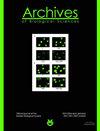Effect of hydric and light stress on biomass, nutrient uptake and enzymatic antioxidants of Argania spinosa seedlings
IF 0.7
4区 生物学
Q4 BIOLOGY
引用次数: 6
Abstract
Sunlight and water are factors that affect seedling development. However, the effects of acclimatization of seedlings to sunlight and water stress remain poorly understood. This study aimed to examine the interactive effects of acclimatization to light and water stress on argan tree (Argania spinosa) seedlings in nurseries. An experiment was conducted with 504 seedlings using two sunlight treatments (L1 and L2, i.e. 100% and 60% of full sunlight, respectively), and three watering treatments (well-watered, moderate stress and severe stress, i.e. 100%, 50% and 25% of field capacity, respectively). According to our results, water stress treatments caused a reduction in total biomass accumulation, nitrogen and phosphorus uptake. Water stress significantly increased other macroelements, H2O2 and MDA levels and antioxidant enzyme activities compared to well-watered seedlings. Seedlings grown under moderate shade (L2) showed higher macroelement uptake, which probably contributed to the increase in total biomass in all water treatments. The highest membrane stability index (MSI) values, H2O2 and MDA levels and lowest antioxidant enzyme activities were recorded in acclimatized argan seedlings under moderate shading (L2). These results suggest that moderate shade can effectively prevent stress caused by light excess and can also mitigate the harmful effects of water stress on A. spinosa seedlings.水分和光胁迫对刺钢幼苗生物量、养分吸收和酶促抗氧化剂的影响
光照和水分是影响幼苗发育的因素。然而,幼苗适应阳光和水分胁迫的影响仍然知之甚少。本研究旨在探讨光照和水分胁迫对摩洛哥坚果树苗木的交互作用。采用2种光照处理(L1和L2,分别为100%和60%的充分日照)和3种浇水处理(充分浇水、中度胁迫和重度胁迫,分别为100%、50%和25%的田间容量),以504株幼苗为试验材料。根据我们的研究结果,水分胁迫处理导致总生物量积累,氮和磷的吸收减少。与水分充足的幼苗相比,水分胁迫显著提高了其他常量元素、H2O2和MDA含量以及抗氧化酶活性。在中等遮荫(L2)条件下生长的幼苗对大量元素的吸收较高,这可能是各水分处理下总生物量增加的原因之一。在中等遮荫(L2)条件下驯化的摩洛哥坚果幼苗膜稳定指数(MSI)最高,H2O2和MDA含量最高,抗氧化酶活性最低。上述结果表明,适度遮荫可以有效地防止光过量造成的胁迫,也可以减轻水分胁迫对刺麻幼苗的有害影响。
本文章由计算机程序翻译,如有差异,请以英文原文为准。
求助全文
约1分钟内获得全文
求助全文
来源期刊
CiteScore
1.40
自引率
0.00%
发文量
25
审稿时长
3-8 weeks
期刊介绍:
The Archives of Biological Sciences is a multidisciplinary journal that covers original research in a wide range of subjects in life science, including biology, ecology, human biology and biomedical research.
The Archives of Biological Sciences features articles in genetics, botany and zoology (including higher and lower terrestrial and aquatic plants and animals, prokaryote biology, algology, mycology, entomology, etc.); biological systematics; evolution; biochemistry, molecular and cell biology, including all aspects of normal cell functioning, from embryonic to differentiated tissues and in different pathological states; physiology, including chronobiology, thermal biology, cryobiology; radiobiology; neurobiology; immunology, including human immunology; human biology, including the biological basis of specific human pathologies and disease management.

 求助内容:
求助内容: 应助结果提醒方式:
应助结果提醒方式:


